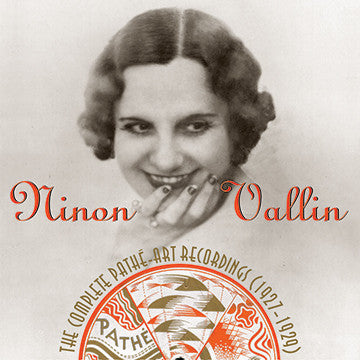|
CD 1 (74:54)
LA BOHÈME: On m'appelle Mimi {Mi chiamano Mimi} (Puccini) [3:38]
1927; (N200912) 7108 (29 cm)
LA BOHÈME: Les adieux de Mimi {Donde lieta uscì} (Puccini) [2:55]
1927; (N200913) 7108 (29 cm)
CARMEN: Habanera (Bizet) [2:42]
1927; (N200914) 7109 (29 cm)
CARMEN: Séguedille (Bizet) [1:57]
1927; (N200915) 7109 (29 cm)
MADAMA BUTTERFLY: Sur la mer calmée {Un bel dì vedremo} (Puccini) [3:18]
1927; (N200929) 7115 (29 cm)
LOUISE: Depuis le jour (Charpentier) [3:13]
1927; (N200930) 7115 (29 cm)
LA BOHÈME: On m'appelle Mimi {Mi chiamano Mimi} (Puccini) [3:33]
1928; (201270) x7145 (29 cm)
LA BOHÈME: Les adieux de Mimi {Donde lieta uscì} (Puccini) [2:55]
1928; (201271) x7145, x7156 (29 cm)
MADAMA BUTTERFLY: Sur la mer calmée {Un bel dì vedremo} (Puccini) [3:14]
1928; (201272) x7143, x7156 (29 cm)
LOUISE: Depuis le jour (Charpentier) [3:33]
1928; (201273) x7143 (29 cm)
THAÏS: Scène du miroir (Massenet) [5:53]
1928; (201274/5) x7144, (29 cm)
Siete Canciones Populares Españolas (de Falla)
- El paño moruno [1:09]
1929; (202443) x3460 (25 cm)
- Seguidilla murciana [1:08]
1928; (201276) x7146 (29 cm)
- Asturiana [1:58]
1929; (202443) x3460 (25 cm)
- Jota [3:00]
1928; (201277) x7146 (29 cm)
- Nana [1:12]
1928; (201276) x7146 (29 cm)
- Canción [1:04]
1929; (202442) x3460 (25 cm)
Polo [1:24]
1929; (202442) x3460 (25 cm)
Le Nil (Leroux) [3:32]
1928; (201282) x7149 (29 cm)
SADKO: Chant hindou (Rimsky-Korsakov) [3:36]
1928; (201283) x7149 (29 cm)
CARMEN: Habanera (Bizet) [2:38]
1928; (201284) x7147 (29 cm)
CARMEN: Séguedille (Bizet) [1:51]
1928; (201285) x7147 (29 cm)
CARMEN: Les tringles des sistres (Bizet) [3:07]
1928; (201286) x7148 (29 cm)
CARMEN: Air des cartes (Bizet) [3:06]
1928; (201287) x7148 (29 cm)
MANON: Voyons, Manon (Massenet) [3:56]
1928; (201429) x7166 (30 cm and 30.5 cm)
MANON: Allons! il le faut... Adieu, notre petite table (Massenet) [3:47]
1928; (201430) x7166 (30 cm and 30.5 cm)
CD 1: All recordings made in Paris by the Compagnie Générale des Machines Parlantes Pathé Frères
Tracks 1-11, 21-26 with orchestra
Tracks 12-18 with Godfroy Andolfi, piano
Tracks 19-20 with violin and piano
Languages: Tracks 12-18 in Spanish, all other Tracks are in French
Pathé x3460--not part of the Pathé-Art series and recorded in late 1929--has been used in conjunction with x7146 to complete the set of de Falla's Siete Canciones Populares Españolas.
CD 2 (76:12)
MANON: Je suis encore tout étourdie (Massenet) [3:39]
1928; (201431) x7165 (30 cm and 30.5 cm)
MANON: A nous les amours (Massenet) [2:31]
1928; (201432) x7165 (30 cm and 30.5 cm)
TOSCA: Prière de Tosca {Vissi d'arte} (Puccini) [3:24]
1928; (201439) x7168 (30.5 cm)
TOSCA: Notre doux nid {No, Mario mio} (Puccini) [4:06]
1928; (201440) x7168 (30.5 cm)
LE NOZZE DI FIGARO: Récit et air de Suzanne {Deh vieni non tardar} (Mozart) [4:16]
1928; (201441) x7167 (30.5 cm)
DON GIOVANNI: Air de Zerline {Batti, batti} (Mozart) [3:45]
1928; (201442) x7167 (30.5 cm)
MANON: Duo de la rencontre (Massenet) [8:42]
with Miguel Villabella, tenor
1929; (202423/4) x7225 (30 cm)
Panis angelicus (Franck) [3:57]
1929; (202438) x7226 (30 cm)
Voici le Noël (arr. Tiersot) [3:53]
1929; (202439) x7226 (30 cm)
LES CONTES D'HOFFMANN: Elle a fui, la tourterelle (Offenbach) [4:07]
1929; (202466) x7227 (30 cm)
MANON: Je marche sur tous les chemins (Massenet) [3:48]
1929; (202467) x7227 (30 cm)
FAUST: Ballade du roi de Thulé (Gounod) [4:39]
1929; (202462) x7228 (30 cm)
FAUST: Air des bijoux (Gounod) [3:49]
1929; (202463) x7228 (30 cm)
THAÏS: Scène du miroir (Massenet) [6:22]
1929; (202464/5) x7229 (30 cm)
L'Invitation au voyage (Duparc) [3:52]
1929; (202476) x7230 (30 cm)
Chanson triste (Duparc) [3:10]
1929; (202477) x7230 (30 cm)
LE ROI D'YS: Margared, ô ma soeur... En silence pourquoi souffrir (Lalo) [6:50]
with Madeleine Sibille, soprano
1929; (250021/2) x7233 (30 cm)
CD 2: All recordings made in Paris by the Compagnie Générale des Machines Parlantes Pathé Frères
Tracks 1-7, 10-14, 17 with orchestra
Tracks 8-9 with M. Vadon, organ
Tracks 15-16 with violin and piano
Languages: Track 8 in Latin, all other Tracks are in French
Producers: Victor Girard, Scott Kessler and Ward Marston
Audio Conservation: Ward Marston
Photographs: Roger Gross Ltd., Jose Pons and Raphael Reszepter
Booklet Design: Takeshi Takahashi
Marston would like to thank Richard Bebb, Stan Farwig, J. Neil Forster, Michael Gunrem, Denys Harry, Lawrence F. Holdridge, John Humbley, Peter Lack, Norbeck and Peters LLC., Jacques Primac, James Shulman and Christian Zwarg for their help in the production of this CD release.
|



